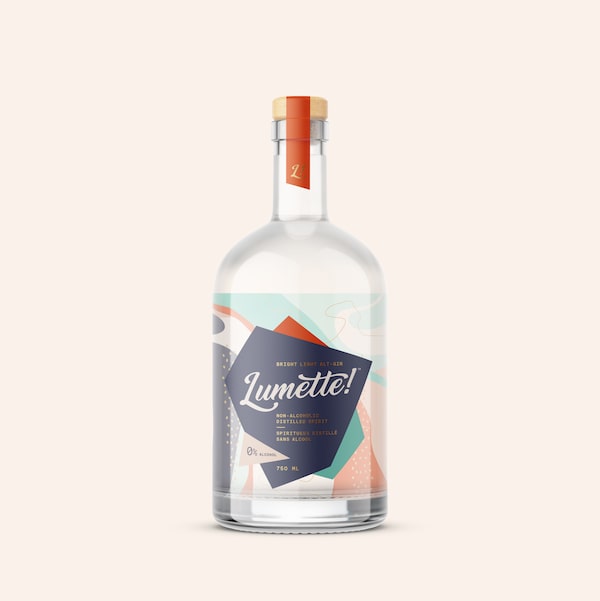It seems like only yesterday that I was eating one of spiciest pieces of fried chicken in my life in Nashville at Hattie B’s. It turns out, it was four years ago.
The other day while grocery shopping, I spotted “Nashville-style hot” chicken nuggets in the freezer section of the grocery store. If you’re wondering how to tell when a food trend has officially peaked, this is a prime example – 2019 was undeniably the year.
Looking ahead into 2020, here are six trends from the West that will likely become more prominent.
The rise of zero proof alcohol

Lumette! is dubbed as an 'alt-gin' and is produced by Sheringham Distillery on Vancouver Island.Berkley Vopnfjord/Courtesy of manufacturer
Sober movements such as Dry January and Sober October may be partly responsible for the growing interest in people quenching their thirst with non-alcoholic drinks.
I’m not talking about your everyday mocktails here. Microdistilleries over the globe have started to develop alcohol-free spirits. Lumette! is dubbed as an “alt-gin” and is produced by Sheringham Distillery on Vancouver Island. It was released at the tail end of 2019 with plenty of buzz and is set to arrive in Alberta, Saskatchewan and Manitoba by the end of the month.
In a similar vein, craft brewers are discovering the value in the near-zero-per-cent craft beers. Partake Brewing is a brewery that exclusively produces this type of craft beer while Village Brewery released its Local pale ale, a 0.3-per-cent beer this summer.
Expect plenty more Canadian-made products such as these.
Single-origin flours
For all of the passionate home bakers out there, this one’s for you. It’s no secret that the Prairies are known as the “bread basket of the world," but it is only recently that artisanal – for lack of a better descriptor – had become more widely available.
Saskatchewan companies such as Daybreak Mill and Two Stones Mill (a brand produced by Saskatoon bakery The Night Oven) are two idyllic examples of operations sourcing organic wheat such as einkorn, red fife and spelt from local farmers and grinding in small batches. This past fall, Two Stones produced a limited amount of purple barley flour, the first of its kind in Canada.
In a similar vein, Flourist in Vancouver is a flour-centric retail store and wholesaler that sources grain from the Prairies and provides traceability with each bag of flour.
Zero-waste (or near-zero) grocery shopping
Food waste and sustainability continue to be at the forefront of people’s minds. It seems that Canadians are continuing to ask themselves how they can make the most of the food they have while making less of an impact on the environment.
The way people shop in Canada has slowly begun to evolve with the introduction of zero-waste shops and grocers such as Unboxed Market in Toronto and The Tare Shop in Halifax. Customers are to bring in their own containers and bags to stock up on fresh produce, condiments, spices and more. Expect Alberta, Saskatchewan and Manitoba to follow suit.
As well, civic and provincial bans on single-use products such as straws and plastic grocery bags are starting to come into effect in places such as Vancouver and Prince Edward Island. A plastic-bag ban is also forecasted in Manitoba.
Consumer food and drink products focusing on minimizing food waste
Following in line with a new grocery-shopping mentality, we are seeing Canadian companies become more innovative with how they create their products. Ontario’s Dairy Distillery is producing the country’s first spirit made from a byproduct of the milk-production process known as milk sugar. NaturalBliss Infusions is a herbal tea company that sources “ugly” tropical fruit from South America, which is dehydrated and turned into tea bags.
Cannabis-infused eating and drinking
Although still very much finding its footing in the food and beverage world, cannabis-infused culinary experiences are sure to be on the rise throughout 2020.
Edibles are now just hitting the legal market in Canada with a 10-milligram limit for THC – as decided by Health Canada – so it’s hard to tell just how many different producers will emerge and how many will find success in a highly competitive market.
One of the leaders in the North American cannabis industry, AgraFlora, recently built a 52,100-square-foot manufacturing facility and pharmaceutical-grade research and development laboratory in Winnipeg.
While edibles such as chocolate, gummies and baked goods will undoubtedly become commonplace, it will still be awhile until you can book a reservation at a restaurant for a cannabis-infused tasting menu.
Plant-based meats 2.0
You can’t drive down a street in any major Canadian city without seeing Beyond Meat advertised on a fast-food sign. A&W set the highly profitable pace in July, 2018, well before plenty of its competitors. Now, Subway, Panago and Quesada are just a few of the chains to have joined the vegan-offering movement.
The fake meat company’s hold on the market is strong, but it will be interesting to see how it holds up (or evolves) as other offerings become available.
Food-trend expert and the director of New Venture Creation at the University of Guelph, Dana McCauley, recently pointed me toward Air Protein, a meat substitute developed by a team of scientists at Berkeley that, as the name implies, grows with airborne micro-organisms that can transform into protein with the help of carbon dioxide.
I’m still wrapping my head around this one.